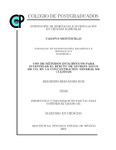| dc.description.abstract | Es muy importante conocer las respuestas fisiológicas de los cultivos a concentraciones atmosféricas de CO2 elevadas, para determinar su efecto en la productividad y calidad del grano o fruto y su concentración mineral. Esto permitirá plantear soluciones que mitiguen el efecto en la reducción de nutrientes minerales para garantizar la salud humana, evitando la desnutrición mineral. Además del aumento en la concentración atmosférica de CO2, los cultivos tendrán que enfrentar mayores niveles de estrés abiótico, debido al incremento en la temperatura del aire y frecuentes periodos de déficit hídrico o sequía. Un conocimiento más profundo del efecto de la concentración atmosférica de CO2 elevado en la concentración de elementos minerales y su relación con la calidad del grano, y la productividad de la planta son imperativos para entender el impacto del cambio climático en la agricultura. De las concentraciones minerales en las partes comestibles de maíz, chícharo, arroz, sorgo, soya y trigo, los mayores efectos debido a las altas concentraciones de CO2 se presentan en las plantas C3 (trigo y soya). Además, las diferencias entre especies de cada cultivo son determinantes sobre la concentración mineral. En los cultivos de chícharo y arroz existe interacción directa entre los cultivares y las concentraciones de CO2, en trigo la interacción más importante es entre riego y las especies. En maíz, el riego no presenta relevancia sobre la concentración mineral en el grano, caso contrario está en la aplicación de nitrógeno como parte de la fertilización durante el ciclo de establecimiento del cultivo, donde sí hay diferencias con cada uno de los niveles, esto último es similar en el cultivo del arroz.
En altas concentraciones de CO2, el cultivo más afectado en la reducción de macronutrientes es el trigo, con una reducción de 6.5% en nitrógeno y 5.8% en magnesio; el arroz presenta fuertes variaciones en nitrógeno (-8.3%) y azufre (-8.0%). Para el caso particular del maíz (tipo C4), el fósforo tiene una disminución de 6.9%, refiriéndose a macronutrientes. En diferentes variedades de arroz, la vitamina B9 presentó una disminución de concentración de 27.3% en promedio; un incremento de concentración solo se registró en la vitamina E (12.9%). _______________ USE OF STATISTICAL METHODS TO INVESTIGATE THE EFFECT OF HIGH CO2 LEVELS ON THE MINERAL CONCENTRATION OF CROPS. ABSTRACT: It is very important to know the physiological responses of crops at high atmospheric concentrations of CO2, to determine their effect on the productivity and quality of the grain or fruit and its mineral concentration. This will allow to propose solutions that
mitigate the effect in the reduction of mineral nutrients to guarantee human health, avoiding mineral malnutrition. In addition to the increase in the atmospheric concentration of CO2, crops will have to face higher levels of abiotic stress, due to the increase in air temperature and frequent periods of water deficit or drought. A deeper knowledge of the effect of high atmospheric concentration of CO2 on the concentration of mineral elements and their relation to grain quality, and the productivity of the plant are imperative to understand the impact of climate change on agriculture. Of the mineral concentrations in the edible parts of corn, pea, rice, sorghum, soybean and
wheat, the greatest effects due to high concentrations of CO2 occur in C3 plants (wheat and soybean). In addition, the differences between species of each crop are determining
on the mineral concentration. In pea and rice crops there is direct interaction between cultivars and CO2 concentrations, in wheat the most important interaction is between irrigation and the species. In corn, the irrigation does not present relevance on the mineral concentration in the grain, otherwise it is in the application of nitrogen as part of the fertilization during the crop establishment cycle, where there are differences with
each of the levels, the latter it is similar in rice cultivation. In high concentrations of CO2, the crop most affected in the reduction of macronutrients is wheat, with a reduction of 6.5% in nitrogen and 5.8% in magnesium; rice shows strong variations in nitrogen (-8.3%) and sulfur (-8.0%). For the particular case of corn (type C4), phosphorus has a decrease of 6.9%, referring to macronutrients. In different varieties of rice, vitamin B9 showed a concentration decrease of 27.3% on average; an increase in
concentration was only registered in vitamin E (12.9%). | es_MX |


